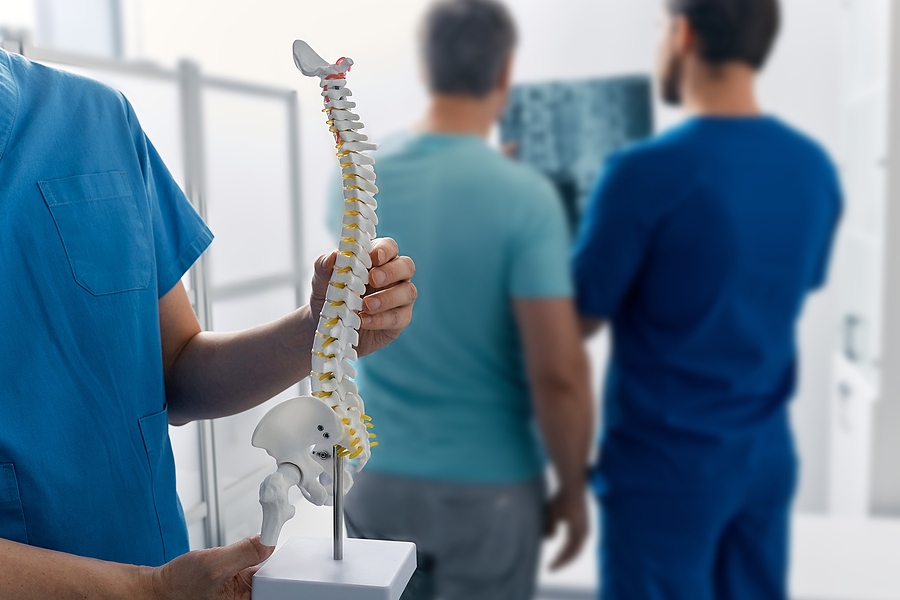A spinal cord injury from a personal injury accident can have life-altering consequences. Spinal cord injuries can vary in severity and location, and understanding the different types of injuries is essential for both victims and their legal representatives.
The following is a brief look at the types of spinal cord injuries victims often suffer in car accidents, truck accidents, slip and fall, and other types of accidents caused by another’s negligence.
If this has happened to you or a loved one, please get in touch with The Eberst Law Firm as soon as you can by contacting us online or calling 1-888-CALL-JON for a free consultation. We’ll work passionately to help you obtain the money you deserve for the suffering you’ve endured.

Complete vs. Incomplete Spinal Cord Injuries
Complete spinal cord injuries cause permanent, total damage to the spinal cord. This damage results in the loss of all sensory and motor functions below the injury site. This means that the affected individual will have no feeling or voluntary movement in the areas below the level of injury. These injuries often lead to paralysis and loss of function in the limbs and other body parts controlled by the damaged spinal cord segments.
An incomplete spinal cord injury means that there’s some remaining function below the injury site. In these cases, the affected body parts may have partial sensation and movement. The degree of impairment can vary widely, ranging from minimal loss of function to nearly complete function.
Incomplete spinal cord injuries provide a glimmer of hope for potential recovery through rehabilitation and medical interventions, as there may be the possibility of regaining some motor or sensory function over time.
Location of Injury
The location of the injury along the spinal cord will determine the long-term impacts the victim will suffer. These areas include the following:
Cervical
Spinal cord injuries in the cervical region, the uppermost part of the spine (neck), can result in quadriplegia or tetraplegia. This means that all four limbs, as well as the torso, may be affected. Depending on the severity of the injury, individuals with cervical spinal cord injuries may require extensive assistance in daily activities, including dressing, eating, and mobility.
Thoracic
An injury affecting the thoracic region of the spine, located in the mid-back, can lead to paraplegia. Paraplegia affects the lower part of the body, including the legs and lower torso, while the arms and upper body remain functional. People with thoracic spinal cord injuries may be able to use a wheelchair for mobility but might have impaired bowel, bladder, and sexual function.
Sacral
The sacral region is the lowest segment of the spine, located just above the tailbone (coccyx). It controls and coordinates the functions of the pelvic organs, lower bowel, and bladder.
Injuries to the sacral region may lead to varying degrees of motor dysfunction in the lower extremities, including the hips and legs.
Depending on the severity of the injury, individuals with sacral spinal cord injuries may experience weakness, decreased coordination, or partial paralysis in their lower limbs. In some cases, bladder and bowel function may also be affected.
Lumbar
The lumbar region is located above the sacral region in the lower back. This portion of the spine controls the lower extremities, including the hips, thighs, knees, and lower legs.
Lumbar spinal cord injuries can result in significant motor deficits in the lower body. Paralysis or weakness in the hips, thighs, knees, and lower legs may occur, impacting an individual’s ability to walk, stand, or engage in weight-bearing activities.
Spinal Cord Injury Grading
Experts widely use the American Spinal Injury Association (ASIA) grading system to classify the severity of spinal cord injuries:
- Grade A: Indicates a complete spinal cord injury with no sensory or motor function below the injury site.
- Grade B: Incomplete injury with some sensation but no motor function below the injury site.
- Grade C: Incomplete injury with some motor function below the injury site, but the muscle strength is insufficient for voluntary movement against gravity.
- Grade D: Incomplete injury with some motor function, and the muscle strength is enough for voluntary movement against gravity but not against resistance.
- Grade E: Normal sensory and motor function, indicating no spinal cord injury.
Symptoms of Spinal Cord Injuries
The symptoms a spinal cord injury victim experiences can vary greatly. They’ll typically depend on how severe the injury is and the location. These are some of the more typical symptoms that occur.
- Loss of sensation and movement below the injury site.
- Muscle weakness or paralysis.
- Difficulty breathing, especially in cervical injuries.
- Changes in sexual function and fertility.
- Loss of bowel and bladder control.
- Loss of temperature and pain sensation.
- Spasms and involuntary muscle movements.
How Does a Spinal Cord Injury Affect Quality of Life?
Depending on the extent of the injury, individuals may require assistive devices like wheelchairs, walkers, or braces for mobility. Long-term medical care, rehabilitation, and physical therapy are often necessary to help individuals adapt to their new circumstances and achieve the highest level of independence possible.
Spinal cord injuries can also lead to emotional and psychological challenges. These can include depression and anxiety as victims try to cope with the loss of their previous abilities.
Recovering Damages for a Spinal Cord Injury
Victims of spinal cord injuries caused by personal injury accidents can pursue compensation for their damages. This includes economic damages, such as medical expenses, rehabilitation costs, lost wages, and future medical care. Non-economic damages, like pain and suffering, emotional distress, and loss of enjoyment of life, may also be recoverable. An experienced personal injury attorney can assist in building a strong case, negotiating with insurance companies, and pursuing fair compensation for the victim’s losses.
Contact The Eberst Law Firm to Speak with an Experienced Personal Injury Law ASAP
If you or a loved one has suffered a spinal cord injury due to someone else’s negligence, contact an experienced personal injury attorney with The Eberst Law Firm. We’ll provide the legal guidance and advocacy to protect your rights and pursue the compensation you deserve. Our team of skilled attorneys will offer compassionate support and fight aggressively for the best possible outcome in your case.
Schedule a free evaluation of your case by calling 1-888-CALL-JON or using our online form.
